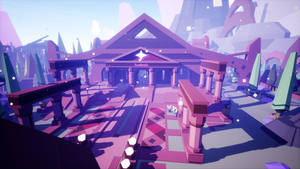Destruction and growth in gameplay: Creating Mushroom 11
"Mushroom 11 is a game about destruction and growth," is how developer Itay Keren describes his game. "You are an amorphous organism, and the only way you move is by destroying your own cells."

Mushroom 11, which comes out this week, is a platformer unlike any other. "Mushroom 11 is a game about destruction and growth," is how developer Itay Keren describes it when he can't show people the game. "You are an amorphous organism, and the only way you move is by destroying your own cells. Destroyed cells immediately grow elsewhere, allowing you to freely shape, trim or split the fungus."
He says he's used the pitch many times, but that even video clips can't accurately convey what it's like to play the game. And I agree. I watched his presentation at Sense of Wonder Night at the recent Tokyo Game Show, where the game won the best game design award, and although that gave me a good grasp of how the gameplay works, it turns out that the game is absorbingly tricky when you actually sit down to play it.
Keren has been making games since he was a kid, and although he spent some time working in non-game software development, he established studio Untame a few years ago.
"I went through different ideas and genres... until I finally found true passion in more experimental, mechanically based games," he says. "My first game was a hard yet casually themed game called Rope Rescue, which I released in 2011. My true passion is demonstrated in Mushroom 11, where I really set to make the game I dreamed of, rather than try to please a certain audience."
Destruction and growth
He first came up with the idea for Mushroom 11 at a Global Game Jam event for which the theme was Ouroboros, the snake eternally eating its own tail.
"What I see in this symbol is the cyclical nature of destruction and growth," says Keren. "As a long time fan of decades of platformers, I wanted to experiment with the idea of making a platformer where you move indirectly by destroying your own cells. That in effect causes a sporadic regeneration, which is the true essence of the game."

According to Keren, the game jam prototype was unpleasant to play, but even then showed promise and was awarded best game design at the GGJ event where it was made. "On the way back home in the subway I started sketching ideas of the things you can do with this novel mechanic," he says. "It was really clear that I could do so much more than the prototype has presented, and I couldn't wait to start investigating this space." It was then that he decided to continue developing the game.
The game is built in Unity, and Keren is thankful for the tool-building time it has saved him. That time has instead gone into figuring out how to design levels for a game with novel mechanics. "The original prototype was pretty much the amorphous fungus set in a standard platformer level," he says. "The idea was new to me, and it took me years, literally, to figure out what a Mushroom 11 level could and should have. Eventually I made a point in not simply including normal platformer obstacles but rather making every challenge unique and tailored to this mechanics."
When asked how long it would take to create another level for the game if he started today, Keren replied, "I have a huge unreleased level with dozens of 'deleted' puzzles or puzzles that just didn't fit mechanically or thematically. So it could be pretty quick. But truthfully, it's probably going to take months to make it just right - as it always does."

Although the game's physics work smoothly from the player's perspective, it seemed to me that the underlying technology must be pretty complicated. Keren said that questions about the game's physics deserve a longer answer than is appropriate for this interview, but pointed me to a talk about it that he gave two years ago. "It's gotten even more complicated since that talk," he says, "and I can say that making the tech took me around half of the four years it took to make the game."
That isn't to say that the game is all about the mechanics. "One of the things I'm particularly proud of is the story, and even more so the storytelling, or lack thereof," Keren says. "There is a pretty large scale and hopefully interesting story that I wrote about the world of Mushroom 11, but instead of telling it to the players in cutscenes and dialogs, we actually hint to the story using background images and artifacts. Figuring out what actually happened becomes a completely separate challenge, almost a game on its own."
Learning the mushroom
One development challenge the folks at Untame ran into was communicating how the game works to new players.
"When you work on a game for so long, you become shortsighted to its novelty and difficulty," says Keren. "Taking it to shows proved that we need to be extremely careful teaching this idea to new users. With the help of my wife Julia, who's also a game designer, we devised a set of rules and a first chapter that's essentially a big hands-on tutorial, teaching one thing at a time, and carefully ramping up the difficulty."

Keren also expected the game to end up being much smaller. "I thought at first that it was going towards the experimental puzzle route where I can lay out a set of consecutive challenges, as I did for my previous game," he says, "but the game really wanted to go towards [being a] large-scale adventure, which ties the story and art into its mechanics."
For all the challenges the game has presented him, however, Keren is glad to have been working on it. "The constant discovery of new things that the mushroom can do has been a constant source of joy in my life for the past few years."
About the Author(s)
You May Also Like













